Balithisweek
This time we will give you 10 place that our resources www.bali-indonesia.com is the best places in bali.
Hope you enjoy.
This Great Article.
Bali Indonesia 10 Best Things to Do in Bali take you straight to the ‘can’t miss’ cultural treasures and famous landscapes found all around the magical island of Bali. There are innumerable temples, historical sites, and spots of natural beauty spread across eight regencies.
This narrowing-down of choices will get you discovering the best of Bali in no time. Go east to see the majestic ‘mother temple’ of Besakih or travel to the heartland where rice paddies offer scenic photo opportunities. From scenic vistas to cultural performances, there is something for everyone.
1. Besakih Temple
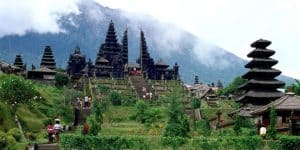
Known as Bali’s ‘Mother Temple’ for over 1,000 years, sits 1,000 metres high on the southwestern slopes of Mount Agung. Besakih is an artistic and unique complex that comprises at least 86 temples which include the main Pura Penataran Agung (the Great Temple of State) and 18 others.
Besakih is the biggest and holiest of the island’s temples and is surrounded by breathtaking and scenic rice paddies, hills, mountains, streams, and more.
To the Balinese, visiting the temple sanctuaries is a special pilgrimage. Mount Agung’s high location gives it an almost mystical quality. Many stairs lead up to the sacred mountain, leading to the many temples that vary according to types, status, and functions.
Pura Besakih features three temples dedicated to the Hindu trinity. Pura Penataran Agung in the centre has white banners for Shiva, the destroyer; Pura Kiduling Kreteg on the right side is with red banners for Brahma, the creator; and Pura Batu Madeg represents Vishnu, the preserver, with its black banners. You can visit other temples in Pura Besakih, but many of their inner courtyards are closed to the public as they’re reserved for pilgrims.
Pura Besakih is the only temple open to every devotee from any caste groups. This is because of its nature as the primal centre of all ceremonial activities.
2. Tanah Lot Temple
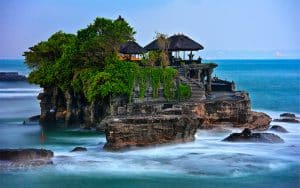
One of Bali’s most important landmarks, famed for its unique offshore setting and sunset backdrops. An ancient Hindu shrine perched on top of an outcrop amidst constantly crashing waves; Tanah Lot Temple is simply among Bali’s not-to-be-missed icons.
The onshore site is dotted with smaller shrines alongside visitors’ leisure facilities that comprise restaurants, shops and a cultural park presenting regular dance performances. The temple is located in the Beraban village of the Tabanan regency, an approximate 20km northwest of Kuta, and is included on most tours to Bali’s western and central regions.
Dang Hyang Nirartha, a high priest from the Majapahit Kingdom in East Java who travelled to Bali in 1489 to spread Hinduism, arrived at the beautiful area and established a site honouring the sea god, Baruna. Here, he shared his teachings to Beraban villagers, only to face opposition from the village chief who soon gathered his loyal followers to dispel Nirartha. The priest resisted, incredibly shifting a large rock he meditated upon out to sea while transforming his sashes into sea snakes to guard at its base. The rock’s original name, Tengah Lod, means ‘in the sea’.
Acknowledging Nirartha’s powers, the humbled chief vowed allegiance. Before setting off, Nirartha gifted him a holy kris dagger, which is now among the sanctified heirlooms of the Kediri royal palace. Pilgrims bring these relics each Kuningan day by foot on an 11km pilgrimage to the Luhur Pakendungan temple, the priest’s former meditational site.
3. Uluwatu Temple, or Pura Luhur Uluwatu
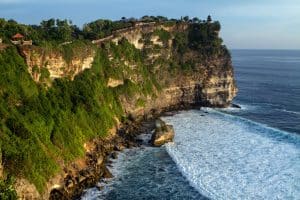
One of six key temples believed to be Bali’s spiritual pillars, is renowned for its magnificent location, perched on top of a steep cliff approximately 70 metres above sea level. This temple also shares the splendid sunset backdrops as that of Tanah Lot Temple, another important sea temple located in the island’s western shores.
Pura Luhur Uluwatu is definitely one of the top places on the island to go to for sunset delights, with direct views overlooking the beautiful Indian Ocean and daily Kecak dance performances. Balinese architecture, traditionally-designed gateways, and ancient sculptures add to Uluwatu Temple’s appeal.
Without a doubt, what makes Uluwatu Temple spectacular is its cliff-top setting at the edge of a plateau 250 feet above the waves of the Indian Ocean. ‘Ulu’ means the ‘top’ or the ‘tip’ and ‘watu’ means a ‘stone’ or a ‘rock’ in Balinese. Several archaeological remains found here prove the temple to be of megalithic origin, dating back to around the 10th century. There are two entrances to Uluwatu Temple, from the south and the north.
A small forest lies at the front and hundreds of monkeys dwell here. They are believed to guard the temple from bad influences. The serpentine pathway to the temple is fortified by concrete walls on the cliff side. It takes about an hour to get from one end to another as there are several fenced points along the way to stop. The views from the bottom of the water surging up against rocks and the ocean horizon are remarkable.
The Balinese Hindus believe that the three divine powers of Brahma, Vishnu, and Siva become one here. That belief results in making Uluwatu Temple a place of worship of Siva Rudra, the Balinese Hindu deity of all elements and aspects of life in the universe. Pura Uluwatu is also dedicated to protect Bali from evil sea spirits.
4. Tegallalang Rice Terraces in Ubud
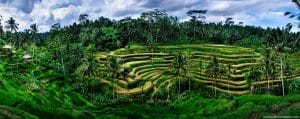
Famous for its beautiful scenes of rice paddies involving the subak (traditional Balinese cooperative irrigation system), which according to history, was passed down by a revered holy man named Rsi Markandeya in the eighth century. Tegallalang forms the three most splendid terraced landscapes in Ubud’s shared region, with the others being in the villages of Pejeng and Campuhan.
Tegallang alone has an outlook that spreads down before you and away to the rice terraces on the slopes across the valley. The high roadside location is cool and breezy and it is a well-known spot for tourists to stop and take photos. Painters and nature lovers also enjoy visiting this spot, and there are numerous art kiosks and cafes near the ledge offering their ware.
Tegallalang rice terraces offer a perfect Bali photo opportunity with its dramatic views. The vista sprawls down and away to the rice terraces on the slopes across the valley. A local elder, a farmer who owns the land invites visitors to sample his green coconut drink, as well as to purchase woven hats that he makes from coconut leaves as well as posing with visitors for a small fee. This ancient valley has a timeless quality whether there are tourists there or not.
The small village of Pakudui, a craftsman’s dominion located in Tegallalang, is a journey of witnessing the splendour of local talent at its best. Here you will find an extraordinary variety of ornamental woodwork and various carvings. The villagers here are avid Balinese craftsmen and have taken up different forms of sculptures, either handed down through generations or as a result of an ever-growing creative process using the most natural of all media – wood. But through your village tour in Pakudui you will notice the recurring presence of one particular mythical Balinese figure – the Garuda.
Amongst the carved mythical lions, horses, human figures, dogs, dragons, vases, frogs, kangaroos, cats, ornate totems, panels, doors, windows, tables and the many brilliant forms of creativity – extending even to large-scale dinosaurs – the Garuda seems to be majestically ever present amongst the creations.
5. Ubud Monkey Forest
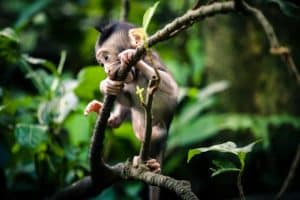
One of Bali’s several grey long-tailed macaque-inhabited forests, and perhaps the best known among the rest due to its community-based management, location and ease of access. It lies on the fringes of the Ubud main centre, and is overseen by the Padangtegal village. Also known as the Sacred Monkey Forest of Padangtegal, and by its official designation as Mandala Wisata Wenara Wana, Ubud Monkey Forest is a place of scientific research as well as a site of spiritual and cultural aspects with temples sanctified by the local villagers deep within its grounds.
While Ubud has long attracted visitors to its cool highland climate and various shopping and dining scenes, it is also renowned as the island’s cultural hub in central Bali. Ubud Monkey Forest on the other hand, serves as a natural attraction and a silent witness to the advent of tourism in the town. It remains a natural landmark and one of the ‘must sees’ while visiting the area.
The one-way Jalan Monkey Forest, and Jalan Hanoman that precedes it, owes their names to the forest. Enter south from the Ubud main town centre and royal palace, and after a curve right, the forest is hard to miss, with a mini-parking space from where public and private transports drop passengers to the right.
The historic Pura Purana temple built in the mid-14th century resides within the forest. Also, one among the three key village temples, namely the Pura Dalem, or crematory and gravesite temples associated with the Hindu god Shiva can be found here. Large trees shade most of the stone pathways, and relics and statues are all covered in moss, which give the place an eerie and ancient feel. Another interesting site within the forest is an ancient bathing temple, located at the northwestern borders of the Ubud Monkey Forest, accessible down a flight of stairs and next to a stream.
6. The Ubud Art Market
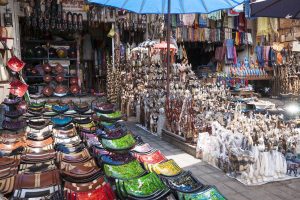
Locally referred to as ‘Pasar Seni Ubud’ is located opposite the the Puri Saren Royal Ubud Palace and is open daily. Here you can find beautiful silk scarves, lightweight shirts, handmade woven bags, baskets or hats; statues, kites and many other hand-crafted goods.
Most of the goods found at the Ubud Market are made in the neighbouring villages of Pengosekan, Tegallalang, Payangan and Peliatan. The location of the Ubud Art Market which is centred among the art producing villages, and being just opposite the royal palace which is a centre point to Ubud itself, make it a strategic shopping place for Balinese handicrafts and souvenirs.
The Ubud market also serves as a setting for the Hollywood movie Eat Pray Love, which shows a scene where actress Julia Roberts opposite a male character strolling through the stalls which are frequently visited by foreign and domestic visitors in real life. Naturally, bargaining is essential.
A holiday in Bali always calls for some sort of shopping for souvenirs or memorabilia of the trip, and the best place to make the search would be in the artistic central region of the island, namely Ubud and its Ubud Art Market.
Bali art markets in general are always on itinerary lists especially as the various items sold are typically Balinese, unique and some unavailable elsewhere. In Ubud’s case, most visitors’ favourite leisure includes easy strolls to the heart of the town, made possible by footpaths that virtually pass every aspect of Balinese culture and life. Ubud Art Market is one among the laid-back strolls, reachable from the Wanara Wana Monkey Forest Sanctuary just down south, an approximate kilometre from the market.
‘Shopping’ here is not always about an actual purchase. Viewing the various items on display from one stall to another is a highlight on its own, showing the craftsmanship and the artistry of the Balinese. Admiring all the shops and stalls usually cannot be accomplished in one day. So if you spot an item of your interest, you might come back another day to bargain or settle the deal.
Compared to art markets in Bali’s other main tourism destinations such as Kuta, the Ubud Art Market can be considered to feature higher quality items and a larger mixture. Although beach cloths and shirts printer with “Bali” on them, and ikat woven skirts, Balinese style paintings, woodcarvings and woven baskets can be found almost everywhere on the island, items ranging from quadruple-coloured bohemian skirts of satin, Moroccan-style oil lamps, quilt-stitched batik camisoles and brass Buddha statuettes, are somewhat the staple, typical Ubud Art Market curios.
7. Bali volcano
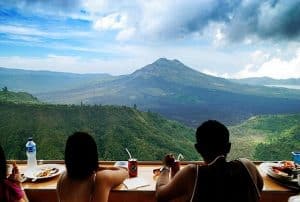
Also known as Kintamani volcano and Mount Batur have been the most favorite tourist destination in the central mountains area of Bali. With the magnificent view of its caldera, and also the beauty of Lake Batur which fills the large part of the caldera, the crater of Mount Batur is the central interest of the place which is estimated to have 13 square km size.
The view is the main reason to come here. Surrounded by the captivating nature of Mount Batur, you will find plenty more reasons to linger in the crater itself, and be sure to also take in the joyous winding road along the lake shore to Toya Bungkah, Pura Ulan Danu Batur, or even the hot springs.
Kintamani area actually consists of 3 main villages including Penelokan, Batur, and Kintamani. There are also some ancient villages around Batur Lake which is often known as Bali Age Village. Penelokan is the vantage point at the southernmost of the crater rim. You will be greeted by a fantastic spectacle as you come over the ridge at Penelokan and gaze down in wonder at the twin caldera of Lake Batur.
Penelokan is the best location to enjoy the panoramic delights of Kintamani with the combination of the lava field, a green carpet of plants, black molten rocks, and the blue-green lake water. Penelokan has hotels and restaurants and is located 1,500 metres above sea level with deliciously cool temperatures.
Gunung Batur comprises three volcanic cones: Batur I, Batur II, and Batur III. Trekking and hiking as well as observing the sunrise are all popular pastimes. • Batur caldera on the northwest of Gunung Batur is one of the biggest and most beautiful in the world. Caldera II is circular-shaped, with a diameter of at least seven kilometres.
Danau (Lake) Batur, located on the southeast side of the volcano, is 16-kilometres wide and is a popular fishing spot.
Toyobungkah has a hot springs and is located by Danau Batur. The water is said to have healing properties and to come from the heart of Gunung Batur. It’s a great fishing spot, and also features an art gallery. Toyobungkah is a popular choice to spend the night before hiking up Gunung Batur to watch the sunrise.
Gong GedeTemple was spared from the massive volcanic eruption in 1926 and is situated in Pura Ulun Danu Batur in the new Batur village. This west-facing temple dates back to the 10th century. On the west of Mount Abang is a secluded village called Terunyan that has held on strongly to its ancient burial tradition of using an open graveyard. Pancering Jagat Temple is located in Terunyan village and its name is derived from a four-metre tall statue called ‘Arca Da Tonta’ or ‘Ratu Gede Pusering Jagat’.
8. Bali Safari & Marine Park
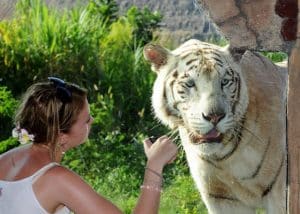
Offers a fun day out, and serves as one of the island’s largest and most visited animal theme parks which opened its gates in 2007. The Bali Safari & Marine Park was established by Taman Safari Indonesia; covering 40 hectares of land in the Gianyar regency. It is home to over 60 species, all of which roam free in large enclosures that mimic their natural habitats.
Enjoy riding on a safari bus to visit the animals, watching fascinating elephant talent shows, get cuddly with baby orangutans, and view baby sharks at the aquarium. Families travelling with children will have a blast together at the adjacent water and amusement parks.
In Bali Safari & Marine Park collection are 80 species and around 400 specimens from three regions – Indonesia, India and Africa, including spotted deers, Himalayan bears, nilgai, black bucks, African hippos, zebras, camels, ostriches, baboons, blue wildebeests, and lions. The most epic on display are the legendary Indian white tigers. Guests board safari buses to travel through different areas of the park.
Bali Safari & Marine Park’s signature Safari Journey takes visitors through the manmade habitats of Indonesia, India and Africa on modified safari trams, providing the opportunity to see the wildlife collection living naturally all together in the open range regions and to take as many photos as they like, all from the comfort and safety of the air-conditioned safari tram with their very own personal guide.
Key exhibits in Bali Safari and Marine Park include Ranthambore, a replica of an ancient Indian fort in the city of Rajasthan where majestic white tigers roam; Kampung Gajah (Elephant Village), a sanctuary for retired working elephants; and the showcase of the komodo dragons. There are also camel and elephant rides to experience as well as fun close-up photo opportunities with some of the animals. Also, check out the various free live animal shows as well as the new Bali Theatre onsite, with the currently-running magnificent Bali Agung show.
9. Bali Elephant Safari Park of Desa Taro
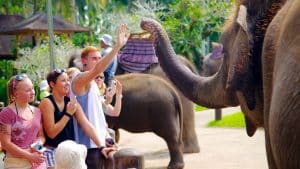
Bali’s majestic elephants can be found at the Bali Elephant Safari Park of Desa Taro, north of Ubud. This park, managed by Bali Adventurer Tours, offers visitors a chance to get up close and personal with the peaceful giants and also to go for a sightseeing expedition on the backs of these towering pachyderms.
Facilities include a full reception and information centre, a safari park lodge, a spa, a comprehensive museum, with a large collection of elephant memorabilia and the only mammoth skeleton in Southeast Asia.
Park facilities include a reception centre with graphic displays of elephant history and physiology, a boutique gift shop featuring a massive range of elephant-related products, a 200-seat restaurant and bar with spectacular views over the lake and park, a snack bar and photo kiosk, a museum with 1,000 exhibits, a 15,000-year-old mammoth skeleton, and an elephant arena and painting display area.
There are safari rides through Taro’s jungles with riders perched in a teak chair on elephant back. After the trek, lunch is served at the park restaurant beside the elephant bathing lake after which everyone heads to the elephant arena for one of three daily talent shows.
Here you can touch and hand-feed the elephants, watch the elephants’ playful bathing rituals, have photos taken with elephants, witness live educational shows and elephant painting, enjoy and learn amazing facts from the information centre, museum and from park staff and participate in children’s mini rides.
10. Goa Gajah or Elephant Cave
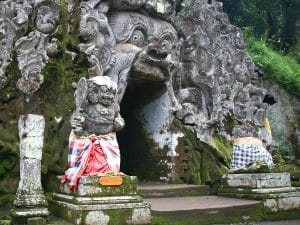
Goa Gajah’s name is slightly misleading, lending the impression that it’s a gigantic dwelling full of elephants. Nevertheless, Goa Gajah ‘Elephant Cave’ is an archaeological site of significant historical value that makes it a special place to visit. Located on the cool western edge of Bedulu Village, six kilometres out of central Ubud, you do not need more than an hour to descend to its relic-filled courtyard and view the rock-wall carvings, a central meditational cave, bathing pools and fountains.
Goa Gajah dates back to the 11th century, built as a spiritual place for meditation. The main grounds are down a flight of steps from the roadside and parking area, which is lined with various art and souvenir shops and refreshment kiosks. Upon reaching the base you will come across a large ‘wantilan’ meeting hall and an assortment of large old stone carvings, some restored to their former full glory. The pool, excavated in 1954, features five out of supposedly seven statues depicting Hindu angels holding vases that act as waterspouts.
Various structures reveal Hindu influences dating back to the 10th century, and some relics feature elements of Buddhism dating even earlier to the 8th century. The cave is shallow; inside are three stone idols each wrapped in red, yellow and black cloths. Black soot lines the cave’s walls as result from the current-day incense burning. Several indentations show where meditating priests once sat. The northern side of the complex is dominantly Buddhist while south across the river it’s mostly Shivaite.
At the southern end are beautiful rice fields and small streams that lead to the Petanu River – another natural site entwined in local legends. Goa Gajah was built on a hillside and as two small streams met here forming a campuhan or ‘river junction’, the site was considered sacred and was built for hermetic meditation and prayers.
See You Next Week…
BREAKING NEWS | HEADLINE NEWS | NEWS | DAILY NEWS | WEEKLY NEWS
WORLD NEWS | INDONESIA NEWS | BALI NEWS



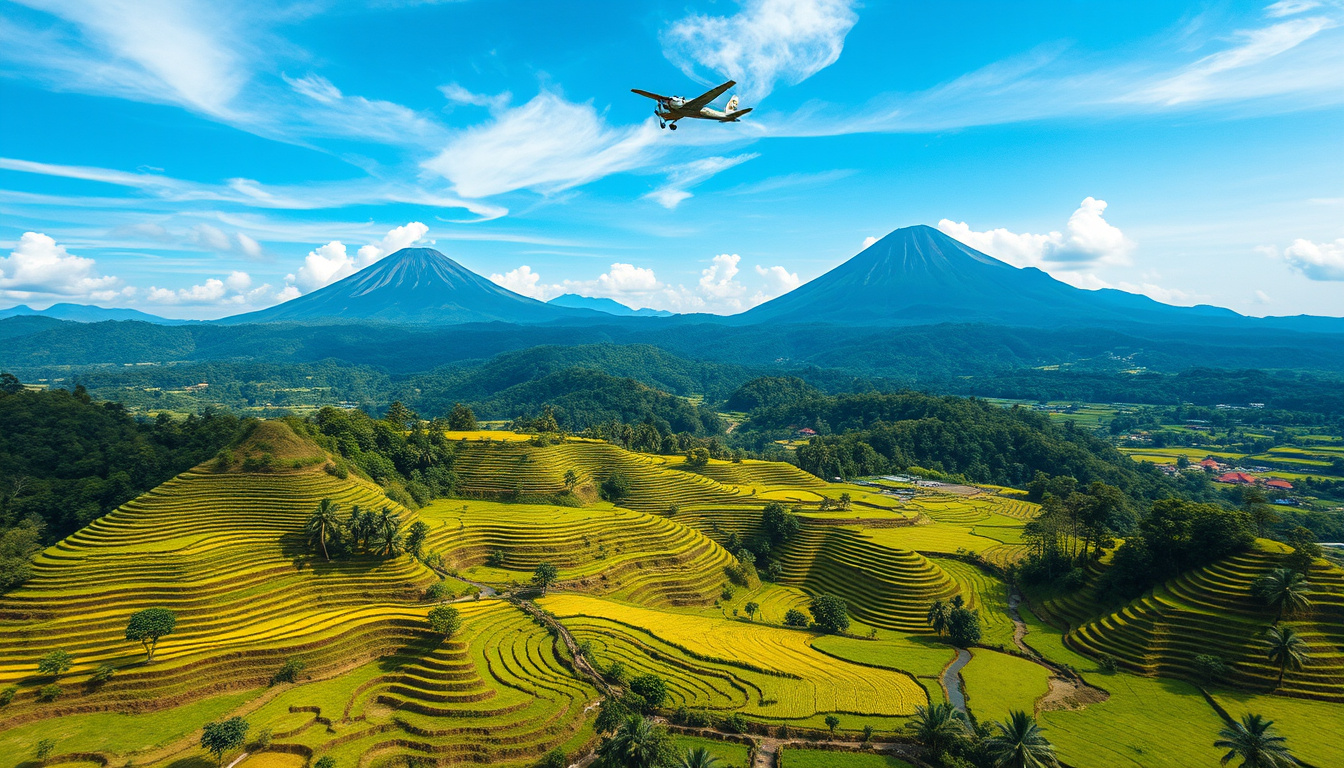
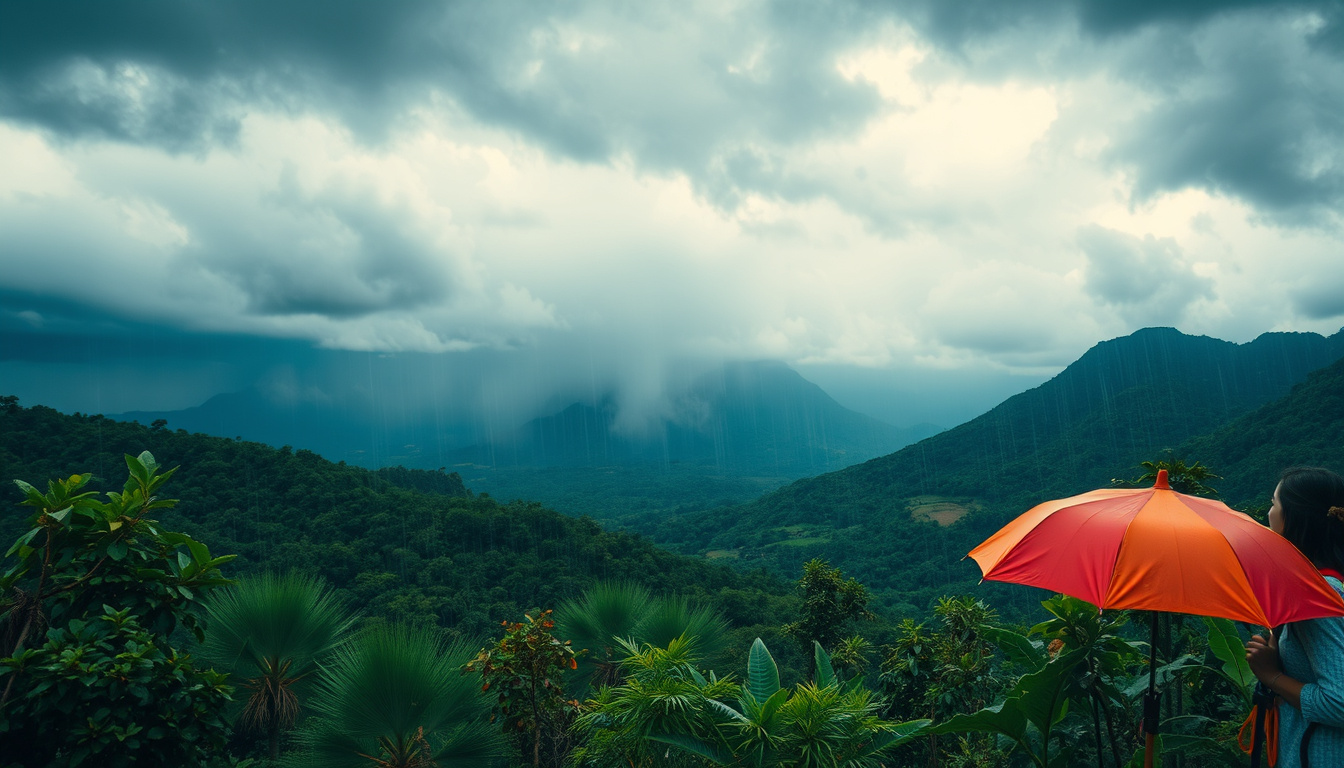
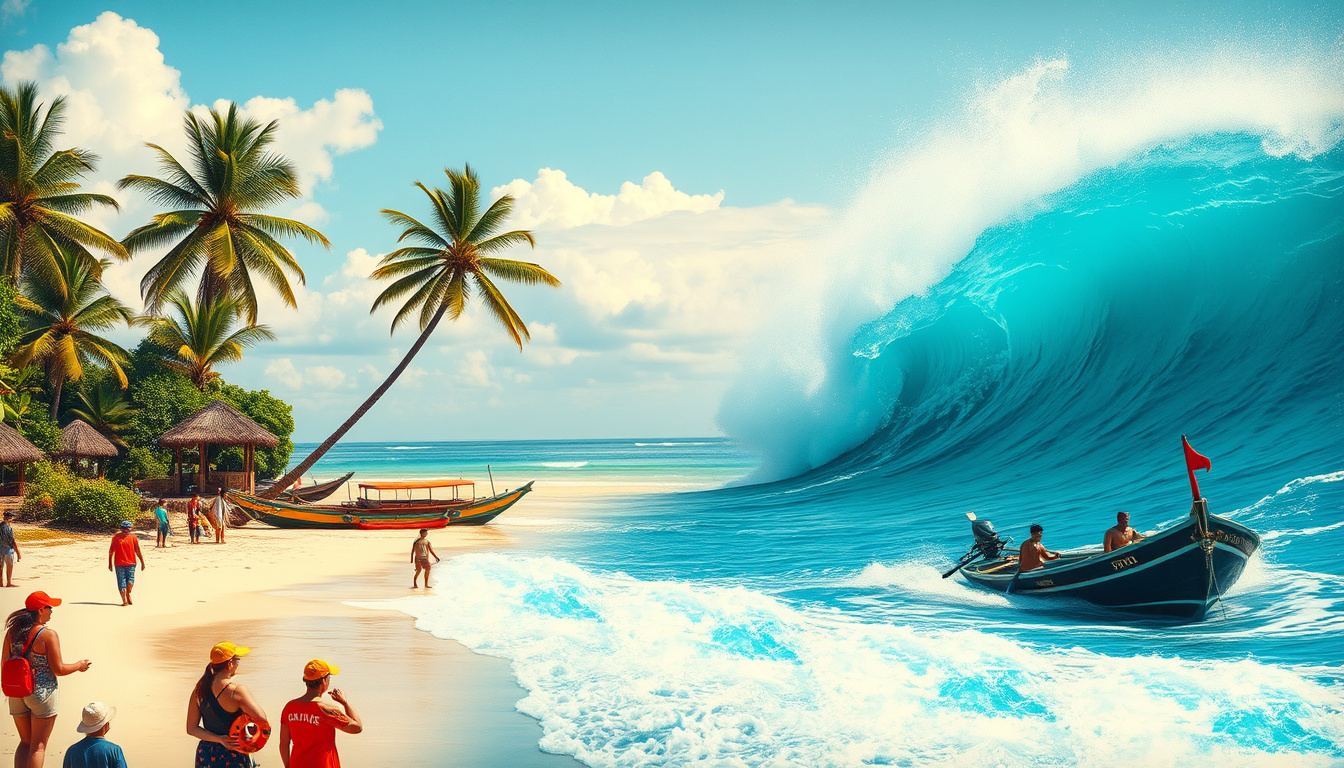
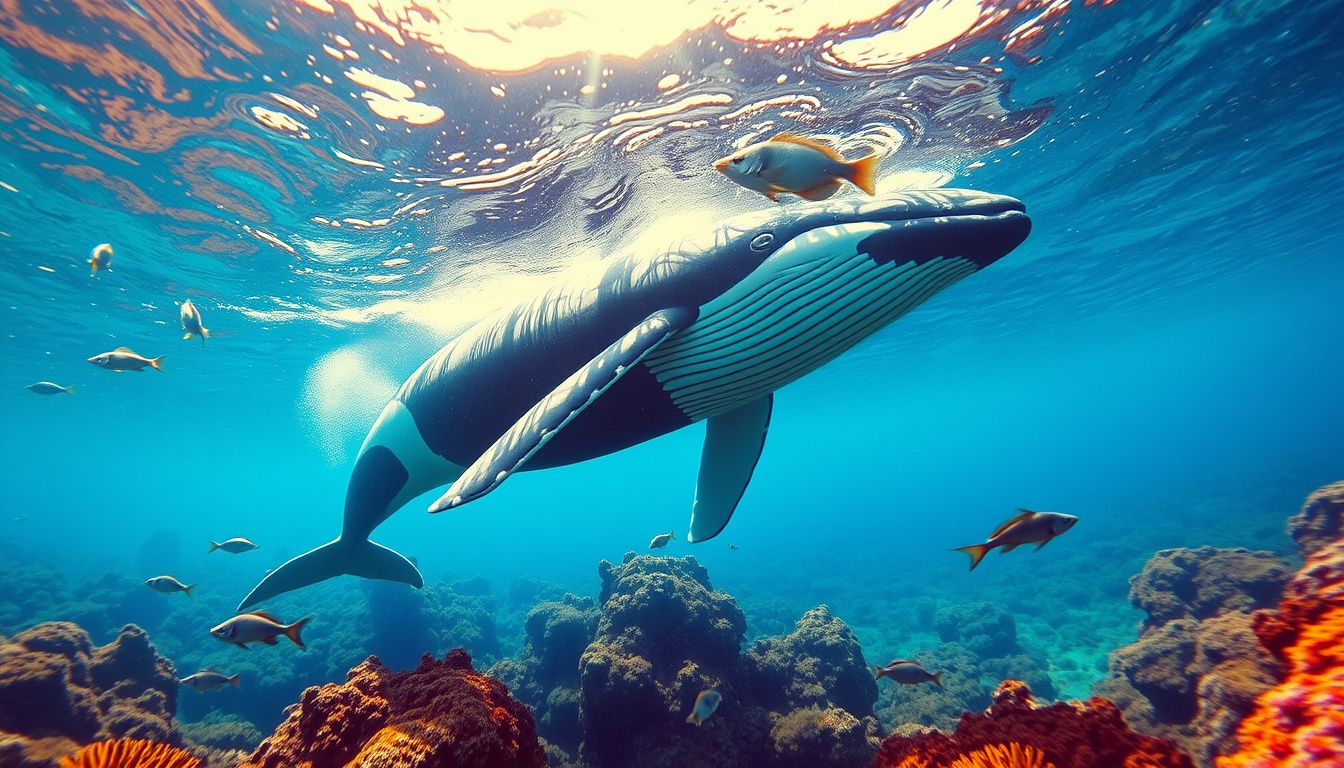
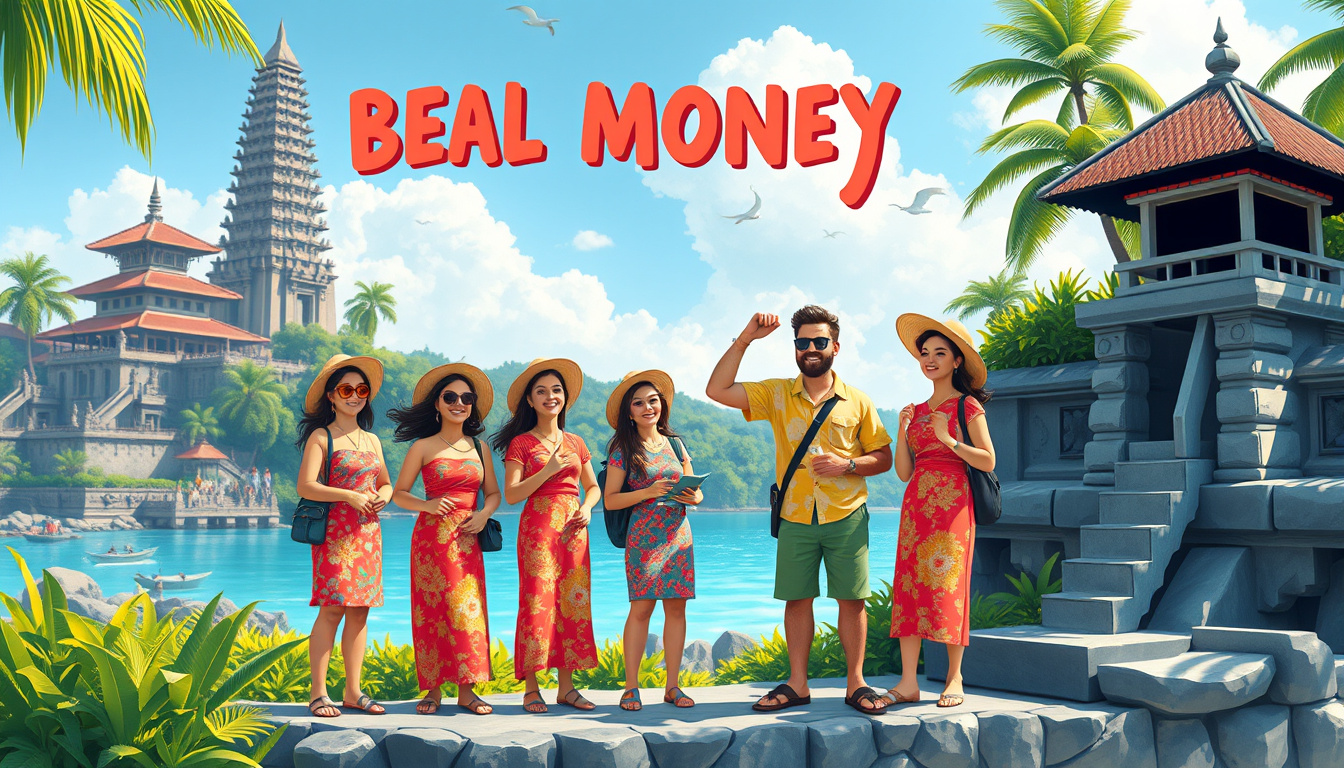


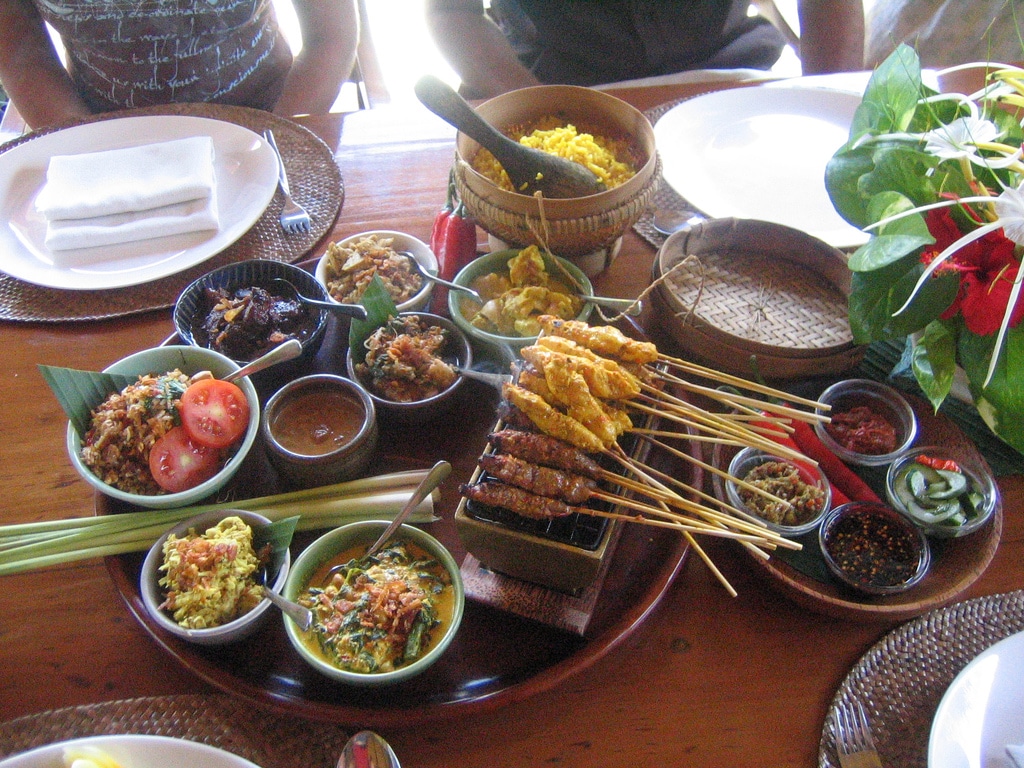
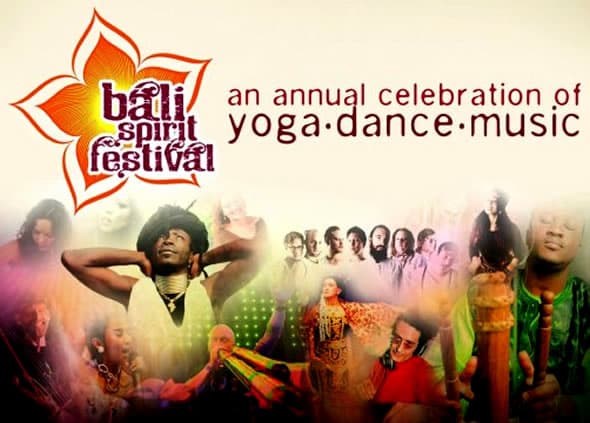



Add a comment